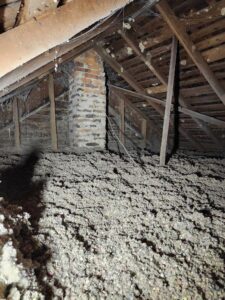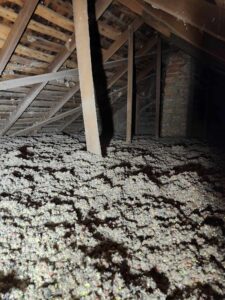What is cellulose blown-in insulation?
Cellulose blown-in insulation is a type of insulation material that is made from recycled paper products, typically newspaper. It is a popular choice for homeowners looking to improve the energy efficiency of their homes. The cellulose fibers are treated with fire-retardant chemicals, making it a safe option for use in residential buildings. Blown-in insulation is installed by using a special machine to spray the cellulose fibers into the desired area, filling gaps and creating a seamless barrier against heat transfer. This type of insulation is known for its excellent thermal performance and soundproofing abilities, making it an ideal choice for those looking to create a more comfortable and energy-efficient living space.

Benefits of cellulose blown-in insulation
Cellulose blown-in insulation offers a multitude of benefits that make it an excellent choice for insulating your home. Made from recycled materials such as newspaper and cardboard, cellulose blown-in insulation is not only environmentally friendly but also highly effective at reducing energy consumption. Its dense composition allows it to fill even the smallest gaps and cavities, creating an airtight barrier that prevents heat loss and drafts. Additionally, cellulose blown-in insulation has excellent soundproofing properties, making it ideal for reducing noise pollution in your home. Furthermore, this type of insulation is resistant to pests and mold, providing a healthier living environment for you and your family. With its numerous advantages, cellulose blown-in insulation is a wise investment that will save you money on energy bills while improving the comfort and sustainability of your home.
How does cellulose blown-in insulation work?
Cellulose blown-in insulation is a highly effective and eco-friendly insulation option for homes and buildings. The process involves using a special machine to blow loose cellulose fibers into the desired space, filling every nook and cranny. These cellulose fibers are made from recycled paper products, such as newspapers, which are treated with fire-retardant chemicals to enhance their safety. Once installed, the cellulose insulation creates a dense layer that effectively traps heat and sound, providing excellent thermal and acoustic insulation. Additionally, cellulose blown-in insulation is known for its ability to resist air movement, reducing energy loss and improving energy efficiency. This sustainable insulation option not only helps to lower energy bills but also contributes to a healthier and more comfortable indoor environment.
Types of cellulose blown-in insulation

Cellulose blown-in insulation is an excellent choice for homeowners looking to enhance the energy efficiency and comfort of their homes. There are various types of cellulose blown-in insulation available in the market, each with its own unique properties and advantages. One common type is loose-fill cellulose insulation, which is made from recycled paper fibers treated with fire retardants. This type of insulation is known for its exceptional thermal performance and ability to reduce air leakage. Another type is dense-pack cellulose insulation, which is installed by densely packing the cellulose fibers into wall cavities. This method provides excellent sound insulation and can also help prevent the spread of fire within the walls. Overall, cellulose blown-in insulation offers a cost-effective and environmentally friendly solution for improving home insulation and reducing energy consumption.
Cost of cellulose blown-in insulation
The cost of cellulose blown-in insulation is a key factor to consider when looking to improve the energy efficiency of a building. While the initial investment may be slightly higher than other insulation options, the long-term benefits far outweigh the cost. Cellulose blown-in insulation is made from recycled paper products and provides excellent thermal performance, reducing heat loss in the winter and heat gain in the summer. Additionally, it is a more environmentally friendly option compared to fiberglass or foam insulation. With its superior ability to fill gaps and create a seamless barrier, cellulose blown-in insulation ensures maximum energy savings and a comfortable living space.
Installation process of cellulose blown-in insulation
The installation process of cellulose blown-in insulation is a cost-effective and efficient way to improve the energy efficiency of a home. This type of insulation is made from recycled materials, such as newspaper and cardboard, that have been treated with fire retardants. The installation process involves using a special machine to blow the cellulose insulation into the desired areas, such as attics or walls. The insulation fills in gaps and voids, creating a seamless barrier against heat loss or gain. This method of insulation is not only environmentally friendly but also provides excellent thermal performance, reducing energy bills and creating a more comfortable living space.
Preparing the area for installation
Preparing the area for the installation of cellulose blown-in insulation is a crucial step in ensuring a successful and efficient insulation process. Before the installation begins, it is important to clear the area of any obstructions or debris that may hinder the installation process. This includes removing any existing insulation, sealing off any gaps or cracks in the walls or ceiling, and ensuring proper ventilation. Additionally, it is essential to protect any sensitive items or surfaces in the area, such as electrical wires or fixtures, by covering them with plastic or cardboard. By properly preparing the area, you can ensure that the cellulose blown-in insulation is installed smoothly and effectively, providing optimal thermal performance and energy efficiency for your space.
Blowing in the cellulose insulation
Blowing in cellulose insulation is a popular and effective method for insulating homes and buildings. Cellulose insulation is made from recycled paper and treated with fire retardants, making it a safe and eco-friendly option. When the cellulose insulation is blown into the walls or attic, it fills all the nooks and crannies, creating a seamless and airtight barrier. This helps to prevent heat loss in the winter and heat gain in the summer, resulting in lower energy bills and increased comfort. Additionally, cellulose insulation has excellent soundproofing qualities, reducing noise transmission between rooms. With its high R-value and sustainable nature, blowing in cellulose insulation is a smart choice for any homeowner looking to improve energy efficiency and reduce their carbon footprint.
Post-installation considerations
Post-installation considerations are an important aspect of cellulose blown-in insulation. While the installation process itself is crucial in achieving optimal energy efficiency and comfort, it is equally important to address certain considerations afterward. One key consideration is the need to ensure proper ventilation in the attic or wall cavities to prevent moisture buildup and condensation. Additionally, regular inspections should be conducted to check for any signs of settling or gaps in the insulation, which may require reapplication. By paying attention to these post-installation factors, homeowners can maximize the effectiveness and longevity of their cellulose blown-in insulation, keeping their homes warm in the winter and cool in the summer while reducing energy costs.
Summary and final thoughts
Cellulose blown-in insulation is a highly effective and environmentally friendly option for insulating your home. Made from recycled paper and treated with fire retardants, this insulation material offers excellent thermal performance and can significantly reduce energy consumption. One of the key advantages of cellulose blown-in insulation is its ability to fill voids and gaps, creating a seamless barrier against heat transfer. Additionally, its dense composition helps to minimize noise transmission, making your home more peaceful and comfortable. By choosing cellulose blown-in insulation, you not only improve the energy efficiency of your home but also contribute to reducing waste and promoting sustainability.

